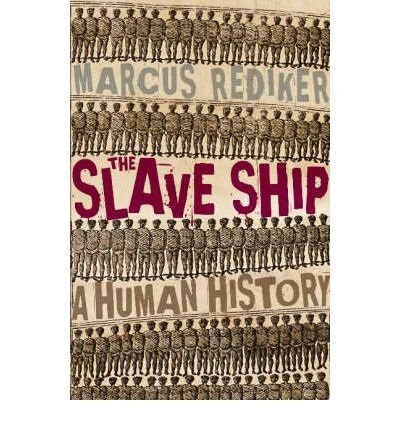
The cover of my edition of Marcus Rediker’s The Slave Ship features a quotation from the Sunday Telegraph describing it as “A truly magnificent book.” Such is my prejudice that I imagine Telegraph readers coming to Rediker’s work not to be educated about the shaping of race and class in the Western hemisphere by the Atlantic slave trade but to bask in reminiscences about the source of their wealth or enjoy some tales of derring-do among the savages. An education is what they will receive, nonetheless, whether they like it or not.
By now, the basics of the slave trade are well known, including its triangular pattern; ships starting in Bristol or Liverpool carried manufactured goods to Africa, which were traded for slaves, who were carried to the Americas and sold to work on the plantations, where the raw materials-cotton, tobacco, and sugar-were bought to undergo modification in the factories and mills of Lancashire, Birmingham, and elsewhere up North, for sale in, among other places, Africa. The slave trade was thus perfectly integrated into the other new markets generated by the Industrial Revolution. It was a business just like any other, a reality that tends to escape analyses of slavery that focus on the barbarity and captivity endured by the slaves to the neglect of the logic behind both.
Not that there isn’t plenty of savagery and captivity to go around. The genius of Rediker’s book is that he has relied heavily on contemporary accounts of life on a slaver, from merchants, captains, sailors, and the slaves themselves. This lends a clarity, vividness, and depth to the story that, while not for the faint of heart, will leave readers in no doubt as to what went on and why. The answer to the big why, of course, is the pursuit of profit. The pursuit of profit explains pretty much everything. But what Rediker manages to tease out in his account are the nuances, the subtle tensions, the balancing act that capitalists have always had to perform, in order to extract labour from the exploited. Anyone who has worked in a factory will recognize, or at least understand, the wheedling, coercion, and incentivization of behaviour deployed by ships’ captains to get the most from their crew and human commodities, even if the cat o’ nine tails is no longer the instrument of choice.
The journey from England to Africa typically saw the modification of the ship by skilled labourers-carpenters and smiths, for instance-who turned it in to a floating prison, a Guineaman, as the slave ships were universally referred to, before its arrival on the shores of such places as Benin, Congo, and Angola. In particular, this part of the journey saw the construction of the barricado, a barricade, a high, strong wooden barrier that stretched across the entire main deck of the ship and behind which the crew could retreat in the case of insurrection by the slaves; the barricado contained holes and a raised platform for the crew to fire their guns and cannon at the slaves, as well as a door that allowed only one person at a time to pass through. The barricado also turned the main deck into a kind of prison courtyard, so that when the slaves were allowed up onto the main deck for “dancing,” the crew could keep an eye on them and fire down on them if necessary.
“Dancing” was, by and large, a euphemism for exercise. The slave merchant had no use for damaged goods, so it was important in terms of maximizing his profit that the slaves he sold in the Americas be fit for work. This necessitated some sort of “humane” treatment, so slaves were fed and watered, but at the same time, the captain had to ensure that fit, strong slaves were never in a position to revolt. “Dancing” thus took place in manacles and leg irons, with slaves supervised and motivated by crew members, under instruction to keep the slaves both healthy and acquiescent. This was a tall order, as you might imagine. Slaves understood the meaning of captivity, even if the technology was new to them, and would do everything in their power to escape or deprive the slaver of their labour. Suicide was common, either by hunger strike or leaping to the sharks that followed the Guineamen knowing there would be food. The ships were thus also equipped with netting around the sides of the decks to prevent such attempts-because the slaves believed that when they died their souls would return home, many drowned not just defiantly but happily-and with the speculum oris, an instrument used to force open the jaws of those recalcitrant slaves refusing to eat. The slave merchants knew there would be deaths on board their ships-cramming as many bodies as they could onto their ships was a recipe for epidemics-but death was always factored into the equation when gauging likely profits. Merchants had a good idea how many deaths to expect, providing mass suicides could be prevented, hence the expectation that the captain would nip any form of resistance, passive or otherwise, in the bud, pour encourager les autres.
Class tensions asserted themselves, too, in the relationship between captain and crew. Few sailors appear to have wanted to sign up on Guineamen. The mortality rate was exceedingly high for crewmembers, the captains were notoriously barbaric, and the morality of slavery was naturally an issue. Many sailors signed up either to get out of prison or to avoid prison. Captains would scour the taverns of port cities with a couple of reliable mates, often family, in search of likely crew, who they’d attempt to get drunk and, with the connivance of a tavern owner in on the scam, draw into debts of such magnitude that they found themselves the next day with the options of either signing up or going to jail. This was no way for a captain to generate loyalty and devotion among his crew, but then he only required their obedience, not their love, and he relied upon the perception of a shared interest in survival once the slaves were on board to solicit the crewmembers’ allegiance. Rediker describes how captains’ personalities and attitudes slowly changed during the journey. Sweetness and light to the crew on the way to Africa, he would turn into a brute to slaves and crew alike once loaded and bound for the Americas. Crews did mutiny, but rarely in unison with slaves, and with a view to selling the slaves themselves on occasion. By and large, though, the captains and mates formed a cohesive group dedicated to realizing the profits at any cost, and so to the extent that they depended upon the crew to do this, the captains would do anything in their power to elicit compliance. A ratio of 8 or 10 slaves to every one crewmember was considered sufficient to meet all needs, including repression. However, once the ship had deposited its cargo in the Americas, many crew became surplus to requirements and would be travelling back to England with nothing to contribute to the bottom line; on the contrary, they constituted a cost insofar as their wages would be paid on arrival. Consequently, toward the end of the second stage of the voyage, just as the slaves were receiving improved treatment to ready them for market, the captains would try to alienate those crewmembers who would not be needed for the journey home, so that they’d jump ship in the Caribbean rather than face the final leg under the captain’s command. This persecution of the crew was deliberate and at the behest of the merchants, who sometimes gave explicit instructions to the captain that they dispose of superfluous crew, even though such a practice was illegal. Rediker tells us that the slave ports were crammed with these pitiful wretches, former crewmembers crippled by disease or unable for one reason or another to get passage home.
Rediker demonstrates how the trade played a part in shaping not just the economic relations between Britain, Africa, and America, but also the social relations and the perceptions of race and class of those involved. Captains often tried to purchase slaves who would struggle in mutual comprehension. If they spoke many and different languages, it followed that they would less likely form a cohesive unit, find common ground, and revolt. A lack of common language made insurrection less likely. Nonetheless, the common experience of captivity transformed slaves, for both themselves and the crew, from being members of discrete, sometimes even antagonistic, African tribes, into “Negroes”, pure and simple, and crewmembers into “White Men”, regardless of the colour of their skin. Race relations were simplified, in effect, because of the universal experience of slavery. Slaves became brothers and sisters regardless of origin, by virtue of their shared experience. New bonds were formed in the face of necessity. Hardship produced co-operation. Slaves may well have found themselves in their predicament as a result of capture by other Africans, but on board ship every African became a brother or a sister. And for the plantation owners who received them, the slaves’ origins were of little consequence; they were a source of labour power and nothing else.
The book closes with accounts of the insurrection by sailors in Liverpool in 1775, in which a thousand sailors wearing red ribbons and armed with muskets, blunderbusses, and cannons attempted to destroy the Mercantile Exchange, and of the role of the slave ship in mobilizing forces to ultimately abolish the trade in Britain. It isn’t part of Rediker’s remit to explore the social and economic factors that contributed to the demise of the slave trade in Britain, only to explain how the slave ship itself played a part in shaping the struggles of those who took part. He does so convincingly, engagingly, and perceptively. This is a book in the tradition of “history from below”, and I couldn’t help but compare it to Silvia Federici’s Caliban and the Witch for the way it demystifies social relations and explains the interplay between class, race, gender, and empire. It isn’t really the kind of book you’re likely to buy as a gift, but it’s a compelling read, and you’ll be doing a really big favour for anyone you buy it for, even if it’s just yourself.
The Slave Ship: A Human History, by Marcus Rediker. 2008. John Murray. 468 pp.

top review matey.
LikeLike
Thanks, Jason. It’s a superb book.
LikeLiked by 1 person
I just finished rereading “Slaves In The Family” by Charles Ball, so this is a timely review! Thank you! xo
LikeLike
You’re welcome! Would you recommend Ball’s book?
LikeLike
Absolutely! Ball, as a white man born here in Savanah, Georgia, uncovered not only the South Carolina planation records of slaves bought and sold, but also discovered the offspring of the Ball family and their slaves. His discoveries also led him to distant family relationships. He found contemporary families that weren’t related, but still had important stories to tell about relationships between whites and blacks. He touched on how at some points in history, blacks that were able to pass for white and completely severed relations with their black families. That alone is a subject for another book! The final chapter in his book covers his visiting the point of origin for enslavement, the West coast of Africa and the responses of those whose families participated in the slave trade. He’s since gone on to write on various subjects, check amazon for more titles.
LikeLike
Will check his stuff out. Thanks a million!
LikeLike